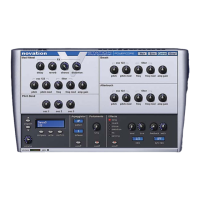Elements of a Sound
Elements of a sound
To gain an understanding of how a synthesizer generates sound, it is helpful to have an
understanding of the components that make up a sound, be it musical or non-musical.
The only way that a sound may be detected is by air vibrating the eardrum in a regular, periodic
manner. The brain interprets these vibrations (very accurately) into one of an infinite number of
different types of sound.
Remarkably, any sound may be described by just three elements, and all sounds always have
them. They are :
* Volume
* Pitch
* Tone
What makes one sound different to another is the proportion of these three qualities initially
present in the sound and how these three terms change throughout the duration of the
sound.
With a musical synthesizer, we deliberately set out to have precise control over these three
elements and, in particular, how they can be changed throughout the duration of the sound.
These elements are often given different names: volume is sometimes referred to as amplitude
and/or level, pitch as frequency and tone as timbre.
Pitch
Taking the example of air vibrating the ear drum, pitch is determined by how fast the vibrations
are. For an adult human the lowest vibration perceived as sound is about twenty times a
second, which the brain interprets as a low, bass type sound and the highest is many
thousands of times a second which the brain interprets as a high pitched sound.
Wave A
Wave B
If the number of peaks in the two waveforms (vibrations) are counted, it will be seen that there
are exactly twice as many peaks in Wave B as there are in Wave A. (Wave B is actually an octave
higher in pitch than Wave A). It is the number of vibrations in a given period that determines the
pitch of a sound. This is the reason that pitch is sometimes referred to as frequency. It is the
frequency of the waveform peaks which are counted during a given period of time. Frequency
is expressed in Hertz (abbreviated to Hz). For example:
20Hz 20 Hz or 20 cycles per second
440Hz 440Hz or 440 cycles per second. This is also known as ‘concert A’ or ‘A-440’
and is the pitch an orchestra tunes to. It is also the common tuning reference
for many other instruments.
1kHz 1,000Hz or 1,000 cycles per second
10kHz 10,000Hz or 10,000 cycles per second
8 Synthesis Tutorial

